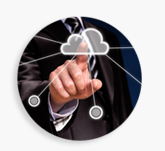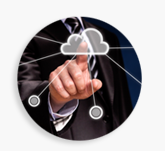 Adaptive Planning was founded just over 10 years ago to deliver cloud financial planning solutions. They have about 1,600 customers across all industries in 80 countries with about 400 partners worldwide.
Adaptive Planning was founded just over 10 years ago to deliver cloud financial planning solutions. They have about 1,600 customers across all industries in 80 countries with about 400 partners worldwide.
 Adaptive Planning was founded just over 10 years ago to deliver cloud financial planning solutions. They have about 1,600 customers across all industries in 80 countries with about 400 partners worldwide. Focused on management planning, reporting, consolidation and analysis they are increasingly in use beyond the finance organization, moving into sales and other operational areas. The current product set is a complete performance management suite with no specific vertical focus. Thanks to their cloud platform, many of their customers start small and expand, adding seats and functionality incrementally over time. The core products are Adaptive Planning, Adaptive Consolidation and Adaptive Discovery. All these are cloud based and support modeling, collaboration and analytics.
Adaptive Planning was founded just over 10 years ago to deliver cloud financial planning solutions. They have about 1,600 customers across all industries in 80 countries with about 400 partners worldwide. Focused on management planning, reporting, consolidation and analysis they are increasingly in use beyond the finance organization, moving into sales and other operational areas. The current product set is a complete performance management suite with no specific vertical focus. Thanks to their cloud platform, many of their customers start small and expand, adding seats and functionality incrementally over time. The core products are Adaptive Planning, Adaptive Consolidation and Adaptive Discovery. All these are cloud based and support modeling, collaboration and analytics.
The Adaptive Discovery product (emerging from their MyDials acquisition, reviewed back in 2009) is focused on visualization, dashboards, KPIs and alerts. This is being used both in the context of the planning tools and as a more general purpose business intelligence/performance management product that can bring together financial information and other data from traditional data stores. Adaptive Discovery is being adopted both to boost analytics and visualization on financial actuals, plans and forecasts as well as to create new analytics from traditional data sources and data warehouses. Examples include supplier spend, inventory analysis, product profitability, category analysis, sales pipeline and accounts receivable.
Key functionality in Adaptive Discovery includes:
- Visualization
Adaptive Discovery supports a wide variety of visualization features out of the box including scorecards, gauges, scatter graphics, radar, trends and more. All of these have support for various collaborative features such as a comment history. The widgets allow for markers such as showing over/under, trends, targets etc. These markers can be flags, color-coding, zones etc. Various analysis approaches can be visualized including min/max, trends, statistical or variance analysis. Targets can be fixed or they can be arbitrarily complex functions and flags /zone markers can reflect that. - Ad-hoc and what-if
The product makes it easy to drill down on any metric y by relevant dimensions. You can also use “time intelligence” to show how things varying overtime. What-If analysis is embedded, allowing users to change values and see the impact of such a change across the whole view. This is integrated with the planning module, allowing such what-if values to drive new plans for example. Any widget can be drilled into in situ, expanding details by geo or product line for instance. As the drill down is continued, different dimensions can be used (going from geo to product line for instance). In situ the user can use the what-if tool to change values and see how the change rolls up to the rest of the dashboard. Data can be filtered using the dimensions and across a timeline, drilling down to an hourly level if you like. - Self-service
The tool is designed to be easy to use, with a web-based drag and drop environment for defining new dashboards from metrics and data. The product is web-based (for both end user and for design environment) and cloud-based. A wide variety of views and dashboards can be designed and access control assigned. All the dashboards can be created and managed using a drag and drop interface. - Mobile application
There is a free mobile app offering a high degree of interactivity. - Cloud-based
The whole environment is cloud based and companies can bring in and automatically integrate data from other sources in the cloud, refreshing on demand or on a schedule. This data can be combined with non-cloud-based sources also. - Embeddable
It is easy to embed the product in operational systems and a number of companies have done so. It is available embedded in Adaptive’s cloud planning tools for instance and NetSuite.
Adaptive is working on allowing the dashboards created to be snapshotted and saved for reporting, both programmatically and visually from the dashboard. They are also working on more advanced kinds of analytics to embed in the environment.
One aside, Adaptive does a lot of work with the Beyond Budgeting Roundtable and one of the key elements here is the idea of continuous planning – rolling forecasts. Integrating this kind of visualization into the planning process clearly helps this mindset, helping people see the impact of ongoing activity on their planning.
You can find more information on Adaptive Discovery here.






